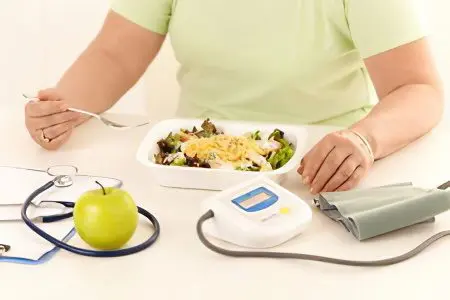Hypertension is fraught with many dangers, and a careless attitude to this disease is fraught with serious problems for human health and life. If a patient has been diagnosed with hypertension, this means that from that day on he must radically change his habitual way of life and even his way of thinking. At the same time, this does not mean that the quality of life of a hypertensive person is significantly worse than that of a healthy person. Compliance with certain rules only indicates respect for one’s own body and the ability to protect one’s well-being.
What shouldn’t be eaten?
It should be noted in advance that many “taboo products” are not recommended to be eaten even by people with a healthy cardiovascular system. Therefore, the rejection of them will benefit any person.
Products, the use of which should be minimized, and it is better to refuse completely:

Fat meat is the main source of cholesterol. You can forget about high-fat red meat. All derivative products are also excluded from the diet: sausage, minced meat, lard, entrails, etc. Rich broths are also unacceptable;
Cakes, cookies, sweets, any muffin -synthesis of sugar and fat. As a rule, it is difficult for a person to control the amount of sweets eaten, so healthy carbohydrates should be preferred;
Coffee, cocoa, chocolate – caffeine negatively affects the work of blood vessels, artificially causing spasms;
Nicotine. Smoking and hypertension are incompatible concepts. During the day, the smoker’s vascular system suffers numerous malfunctions and becomes unable to independently regulate all processes.
Dietary restrictions
The main rule is moderation. Portions should be approximately equal in size, between their receptions there should not be large breaks. Hypertensive patients need at least four fractional meals a day. The last meal is the lightest, no later than two and a half hours before bedtime.
It is recommended to limit the consumption of the following products as much as possible:
Edible salt – Sodium directly affects the increase in blood pressure levels. This element retains excess fluid in the body and, accordingly, increases the volume of circulating blood. It is necessary to refuse to add salt to food during cooking, since you can get the daily allowance of sodium chloride (no more than 5 g) from natural products. In order for the food not to seem tasteless, it is worth using various herbs and spices;
Animal fats – from all consumed fat, their amount should be less than a third. Butter, sour cream, cream should be replaced with vegetable oil (sunflower, olive, linseed). The consumption of cheese is reduced to a minimum, as well as fats in confectionery;
Fish caviar – contains a high level hard to digestх lipids, as well as a large amount of salt. However, at the same time, fish caviar contains a lot of healthy omega-3 fat, which is necessary for hypertension;
Easily digestible sugars – the main cause of excess weight – the best friend of high blood pressure. Jelly, sweet compotes, fruit drinks, jelly, jam and honey are allowed only in small quantities. You should not overeat natural products such as dried fruits – they also have a lot of sugar;
Legumes and mushrooms – these products are hard to digest by the body;
Black and strong green tea lead to excessive vascular tone;
Alcohol – the cause of a huge load on the heart. The maximum daily dose is 150 grams, no more than twice a week.
The use of these products should be the exception rather than the rule. A hypertensive patient must remember that he can afford it only as an addition to the main portion, which consists of the food recommended to him. In the case of abuse of the above products, they turn from permissible to prohibited.
What should you eat?

A specialized physician will help to correctly form a diet, taking into account all the characteristics of the body and the stage of the disease.
There are a number of universal recommendations for nutrition in hypertension:
The basis of cooked side dishes should be cereals, as well as potatoes and other vegetables. Pasta and white bread should be much rarer;
It is desirable to add greens to dishes: dill, parsley, spinach. Garlic and onion are extremely useful. These plants compensate for the lack of salt and strengthen blood vessels;
It is recommended to drink at least one glass of unsweetened rosehip broth per day. The drink will lower the level of excess sugar in the blood;
Preference should be given to dairy products with a minimum fat content. The amount of protein and calcium in them is not less than in fatty ones;
Be sure to observe the daily intake of potassium and magnesium. To do this, you need to know the list of products containing these trace elements (see below);
Soups are best cooked on the basis of vegetables and cereals. The broth on lean meat should be no more than once a week.
The basis of the diet is:
Fresh and frozen vegetables, fruits, berries;
Cereals (oatmeal, millet, buckwheat, rice);
Nuts (walnuts, almonds, peanuts, hazelnuts), seeds and bran. But strictly in limited quantities!
Rye bread;
Seafood (mussels, shrimp) and fish (it is better to give preference to low-fat varieties).
General recommendations
The daily diet for hypertension should contain the norm of organic trace elements (especially magnesium), vitamins P, C and a number of group “B”.
The most important are potassium, magnesium and calcium, the daily norm of which is:
Potassium – 3000-5000 mg;
Magnesium — 400 mg;
Calcium – 800-1200 mg.
Table of products containing the necessary elements:
Magnesium | potassium | Calcium |
|
|
|
In conclusion, it should be said that a well-designed diet for hypertension can be quite diverse in order to facilitate the transition to the right lifestyle as much as possible and protect the health of the patient.









